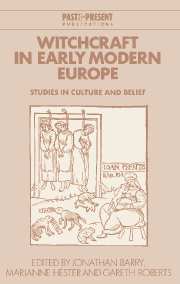Book contents
- Frontmatter
- Contents
- Preface
- Contributors
- 1 Introduction: Keith Thomas and the problem of witchcraft
- PART 1 THE CRIME AND ITS HISTORY
- PART 2 WITCHCRAFT AND RELIGION
- PART 3 THE MAKING OF A WITCH
- 7 The descendants of Circe: witches and Renaissance fictions
- 8 Witchcraft and fantasy in early modern Germany
- 9 The devil in East Anglia: the Matthew Hopkins trials reconsidered
- PART 4 WITCHCRAFT AND THE SOCIAL ENVIRONMENT
- PART 5 DECLINE
- Index
- Past and Present Publications
9 - The devil in East Anglia: the Matthew Hopkins trials reconsidered
Published online by Cambridge University Press: 06 July 2010
- Frontmatter
- Contents
- Preface
- Contributors
- 1 Introduction: Keith Thomas and the problem of witchcraft
- PART 1 THE CRIME AND ITS HISTORY
- PART 2 WITCHCRAFT AND RELIGION
- PART 3 THE MAKING OF A WITCH
- 7 The descendants of Circe: witches and Renaissance fictions
- 8 Witchcraft and fantasy in early modern Germany
- 9 The devil in East Anglia: the Matthew Hopkins trials reconsidered
- PART 4 WITCHCRAFT AND THE SOCIAL ENVIRONMENT
- PART 5 DECLINE
- Index
- Past and Present Publications
Summary
The East Anglian witchcraft trials of 1645–7 constitute one of the most remarkable episodes in the history of the European witchcraze. Despite the survival of a large body of relevant source material, there are sufficient gaps in the records to make it unlikely that the full story of what happened during this outbreak of witch hunting will ever be completely reconstructed. Let us remind ourselves, however, of the main outlines. Over the winter of 1644–5 Matthew Hopkins, an obscure petty gentleman living at Manningtree in north-east Essex, became worried about witches in his neighbourhood. His worries bore fruit in the prosecution of thirty-six witches, of whom perhaps nineteen were executed, at the summer 1645 assizes in Essex. Accusations spread rapidly over the Suffolk border, and we know of 117 witches who were examined or tried in that county. A stray reference suggests that another forty were tried at the Norfolk assizes, while it seems that a further six were tried (and five subsequently executed) at the Great Yarmouth borough sessions. Further trials (we have no way of calculating their total, although they were probably not numerous) occurred in Cambridgeshire, Huntingdonshire, Bedfordshire and Northamptonshire during 1645–6, while a body of depositions in the records of the Isle of Ely assizes reveals that a further seventeen suspected witches were examined there in 1646–7. Altogether we have references to some 240 alleged witches who came before the authorities during this episode, over 200 of them between July and December 1645.
- Type
- Chapter
- Information
- Witchcraft in Early Modern EuropeStudies in Culture and Belief, pp. 237 - 254Publisher: Cambridge University PressPrint publication year: 1996
- 4
- Cited by



